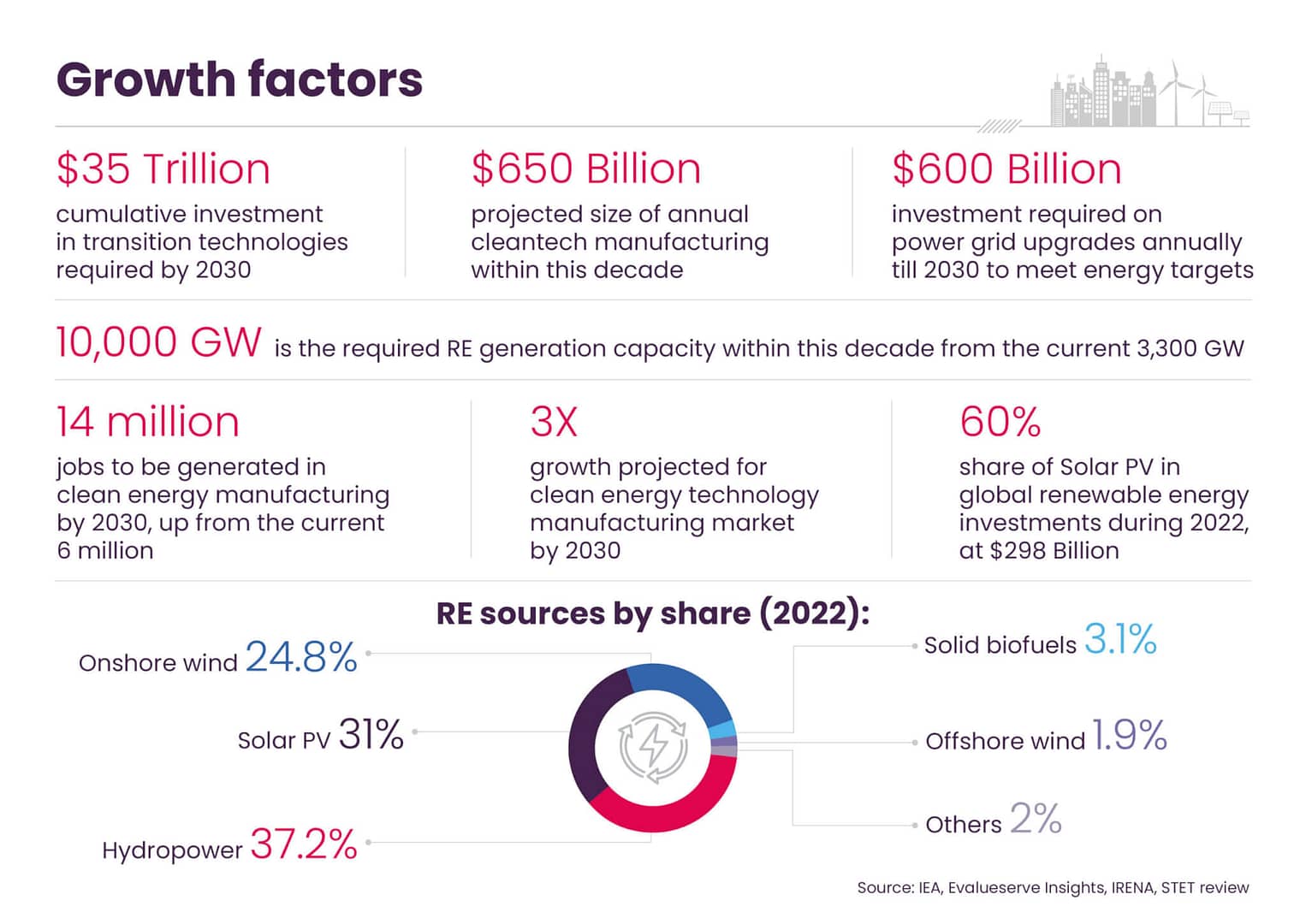Introduction
Renewable energy (RE) is driving the energy transition, giving us first glimpses of the dawn of a clean energy industrial age. Empowering this new economy of the future are technologies and solutions that align with the need for more efficient transition pathways, while also elevating the pace at which new energy supply chains can be created. These new pathways based on RE sources including Solar PV, wind, and hydropower can enable a stronger movement towards the Net Zero 2050 climate change mitigation goals.
Clean energy technology or cleantech solutions will form the basis of the next wave of pathways. They work adjacent to principles informed by recent changes in economies across the world, which have in some ways suffered due to the post COVID-19 energy crisis. The faster adoption of cleantech, more efficiency, better suitability to specific energy security needs, and a collective wider range of applications will prove a distinguishing factor when set against the basic renewable energy pathways we have witnessed so far.
These newer solutions might also offer a better chance of overall inclusivity as more emerging economies can participate in this global industrialisation of clean energy. Let’s take a look at some of the top cleantech solutions and applications – each representing an opportunity to the tune of billions of dollars, and a collective scope in the trillions – as well as the clean energy future they will empower:
Cleantech scope
With major investments already lined up and government incentivised funds earmarked for various pathways to energy transformation, the developments in cleantech solutions will be closely guided by the preferred renewable sources by geographies and industries. Of these, Solar PV has witnessed unprecedented growth since 2019, followed by wind.
The other major focus area has been securing energy supply chains, as well as rapidly enhancing power transmission through grids. One more factor affecting a geography’s energy source choices has also been to ensure the projected growth results in financial security for citizens. Hence, the wide scope of employment the transition offers will play a key role, as well. To identify the most impactful opportunities, it is important to see which way the metaphorical wind is blowing.

Future cleantech solutions
The scope and future projections point to significant investments towards cleantech solutions which speak to the need for grid upgradation, higher energy efficiency, and security for existing RE sources, as well as the advancement of popular transition pathways. It is estimated that two-thirds of the pathways to Net Zero 2050 could come from investments in clean energy technologies and manufacturing. With these inputs in mind, we have identified solutions that have already garnered interest by way of successful research and deployment at varying scales, with a likelihood of becoming the breakthroughs that could address future global clean energy needs.
HRES: What’s better than one RE source? More! Utilising multiple sources such as solar and wind to work in conjunction with the help of smart grids, as well as energy storage will make energy transmission, storage, as well as consumption efficient and economical. There are already working small-scale hybrid renewable energy systems (HRES) projects that reduce setup and operational costs by about 40%.
Super grids: We have already highlighted concerns about the possible impact of the pace of power grid upgradation on the overall energy transition. Part of these concerns arises from the walled-off transmission of renewable power using existing grids, which transmit only within closed regions. Whereas experts are increasingly weighing in on a future wherein power will primarily come from renewables and the use of high-voltage direct current (HVDC) lines to connect various grids into massive super grids efficiently. Such super grids are already being planned and developed for the EU countries, Asia, and the Americas, with more in the works, enhancing energy security across energy-scarce geographies while reducing power losses from under-utilisation.
Microgrids: These mini grids, also referred to as energy islands, form smaller closed-off inter-connected energy distribution systems that can prove useful, self-reliant, and resilient in discrete geographic locations. HRES can be one application of microgrids. These grids can be self-sufficient when the need arises and depending on energy requirements or surplus can connect to centralised grids to receive or transmit energy. Microgrids also enable higher safety as they can continue to provide power in calamitous weather, outage-prone regions, or high-security locations which may be targets for cyberattacks.
Wireless energy: Even as newer ways to transmit energy are being developed and deployed, the century-old idea of one Nikola Tesla was recently achieved by a team of researchers from Caltech. The team was able to transmit energy from space-based solar panels wirelessly down to earth. The technology is called Microwave Array for Power-Transfer Low-Orbit Experiment (MAPLE) and is in early development stages, but with successful tests, it is only a matter of time before borderless, uninterrupted energy transmission reaches marketisation. Some existing examples of near-field wireless energy transmission can be seen in the electric vehicle (EV) as well as smartphone device wireless charging technologies.
Transparent solar panels: Innovations in the field of solar PV development have been gathering more and more traction as the energy source comes to prominence in the future of clean energy. We have already been witnessing conventional solar panels increase in efficiency. Now comes a new innovation that promises greater surface applicability thanks to one critical factor, it is transparent. Transparent solar panels, which could use windows and other functional areas of buildings, will widen applicability and increase surface use in urban settings to generate electricity. The transparency is achieved through a see-through solar PV film applied to conventional glass windows.
Fusion breakthrough: How about an energy pathway that multiplies the energy it receives from its source? A major clean energy science breakthrough was achieved towards the end of 2022. The Lawrence-Livermore National Laboratory in the US announced it had been able to reach fusion ignition through history’s first controlled fusion experiment. The experiment’s major breakthrough is scientific energy breakeven, which means it resulted in more energy being generated from the fusion process than the energy from lasers used to drive it. Clean fusion has long been a pipedream and has been touted by many as one of the ultimate sources for a clean energy future with unparalleled efficiencies. With this step, we move closer to its eventual advent.
Blowhole turbines, floaters: Tidal or wave energy is one avenue wherein various applications are being developed. Artificial floating blowhole formations direct ocean wave swells to create a pressurised air vacuum, which then drives a turbine to generate energy. This energy is then sent back to shore for transmission or storage. Meanwhile, wave energy floaters utilise the kinetic energy of ocean waves to drive a mechanical device that generates electricity.
Energy storage: Since most of the current RE sources provide intermittent energy generation, energy storage is essential at all stages to either store and distribute power or augment the constant load requirements to keep the grids from facing outages. Even as less water-intensive lithium-ion methodologies are being developed for lithium extraction, there are multiple other storage solutions being researched and implemented. Among these, underground pumped storage, compressed air, and stacked blocks storages store potential energy, while hydrogen storage is another solution, wherein the created element is stored in gas or liquid form after electrolysis.
Driving things forward
There is no dearth of cleantech solutions, applications, and pathways being explored, and the ones we have presented here are a compilation of those which appear to directly address an existing or near-term requirement in the evolution of clean energy. We can clearly see the scale of the new industrial age of clean energy, which will make it a centrepiece of future sustainable markets. The variety of grid and energy storage applications being deployed shows how seriously energy security is being taken in a post-energy crisis world.
At the same time, we are once again witnessing a concentration of investments towards clean energy technologies and capacities – nearly 90% - focussed on a handful of countries. We know the consequences of too much reliance on a single or very few sources, from the recent energy crisis and the resultant effect on the global economy. It is time for higher global collaboration and coordination.
Some experts opine we are well past the point where individual efforts by geographies, without collaborative global solutions, can push forth the movement to decarbonisation. It would certainly be beneficial to emerging economies to witness more diversification in the global cleantech supply chains.
There is a race to find strong footholds in the cleantech space. While competition may spell good economic health, it would be best if we collectively do not lose sight of the ultimate target – meeting the Net Zero 2050 CO2 emissions goals, and limiting global temperature rise to 1.5 degrees Celsius from pre-industrial levels.
To know more about how Evalueserve can empower your Decarbonization journey, please reach out to our team of experts at decarbonization@evalueserve.com


